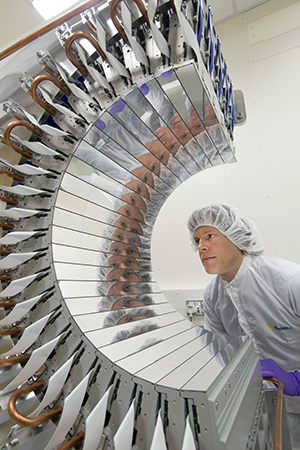Scientists have improved a naturally occurring enzyme which can digest some of our most commonly polluting plastics.
The discovery could result in a recycling solution for millions of tonnes of plastic bottles, made of polyethylene terephthalate, or PET, which currently lasts for hundreds of years in the environment.
The research was led by teams at the University of Portsmouth and the US Department of Energy’s National Renewable Energy Laboratory (NREL) and is published in Proceedings of the National Academy of Sciences (PNAS).
Professor John McGeehan at the University of Portsmouth and Dr Gregg Beckham at NREL solved the crystal structure of PETase—a recently discovered enzyme that digests PET— and used this 3D information to understand how it works. During this study, they inadvertently engineered an enzyme that is even better at degrading the plastic than the one that evolved in nature.
The researchers are now working on improving the enzyme further to allow it to be used industrially to break down plastics in a fraction of the time.

Professor McGeehan, Director of the Institute of Biological and Biomedical Sciences in the School of Biological Sciences at Portsmouth, said: “Few could have predicted that since plastics became popular in the 1960s huge plastic waste patches would be found floating in oceans or washed up on once pristine beaches all over the world.
“We can all play a significant part in dealing with the plastic problem, but the scientific community who ultimately created these ‘wonder-materials’, must now use all the technology at their disposal to develop real solutions.”
The University of Portsmouth and NREL collaborated with scientists at the Diamond Light Source in the United Kingdom, a synchrotron that uses intense beams of X-rays 10 billion times brighter than the sun to act as a microscope powerful enough to see individual atoms.
Professor McGeehan said: “The Diamond Light Source recently created one of the most advanced X-ray beamlines in the world and having access to this facility allowed us to see the 3D atomic structure of PETase in incredible detail. Being able to see the inner workings of this biological catalyst provided us with the blueprints to engineer a faster and more efficient enzyme.”

Significantly, the enzyme can also degrade polyethylene furandicarboxylate, or PEF, a bio-based substitute for PET plastics that is being hailed as a replacement for glass beer bottles.
Professor McGeehan said: “The engineering process is much the same as for enzymes currently being used in bio-washing detergents and in the manufacture of biofuels – the technology exists and it’s well within the possibility that in the coming years we will see an industrially viable process to turn PET and potentially other substrates like PEF, PLA, and PBS, back into their original building blocks so that they can be sustainably recycled.”
The research was funded by the University of Portsmouth, NREL and the Biotechnology and Biological Sciences Research Council (BBSRC).
Principal beamline scientist on I23 at Diamond, Dr Armin Wagner, said: “The long-wavelength macromolecular crystallography beamline I23 at Diamond is an incredibly advanced and unique facility that enables us to solve structures that are usually difficult to characterise. In the case of PETase, the protein crystals diffracted really well and we were able to achieve very high resolution. While most of the known protein structures have been determined to resolutions between 1.5 and 3.0 Å (0.15 – 0.3 nanometres), and we could achieve from for one of the investigated structures 0.92 Å. It basically makes what we are looking at much clearer and therefore easier to understand.
“The high-resolution 3D structure allowed us to get a clear picture of where the enzyme grips its target which then informed the next step of computational modelling to investigate the mechanism of PET degradation further. The large, curved area detector in combination with the vacuum environment on the I23 beamline is ideal for this work as it allows high-resolution structure determinations at low X-ray doses limiting detrimental radiation damage effects to the crystals.”
Header image:
Global blight: Plastic bottles take centuries to biodegrade, but new enzyme discovery brings hope CREDIT: DAVID JONES
You may also be interested in: Plasticity – Towards an Urban Plastic Refinery


amazing
LikeLiked by 2 people